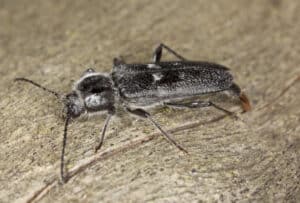
While most people aren’t as familiar with old house borers as other wood-damaging pests, they are common in the U.S., particularly along the Atlantic Seaboard. These black beetles cause damage to wooden structures at rapid speeds, creating a need for expensive repairs and replacements. Read this article to learn about old house borer beetles and how to prevent a possible infestation in your home.
What are old house borers?
Old house boring beetles are also known as long-horned beetles or by their scientific name, Hylotrupes bajulus. They originated in North Africa but are now present all over the world, including in the U.S. Old house borers are a pest that infests buildings and lumber. They typically don’t infest living trees, stumps, or firewood. Instead, an infestation usually starts in chopped lumber that had larvae before construction.
The old house borer life cycle is a comparatively slow process. The average development period is around three to six years. Old house borer larvae can mature in two years in the right conditions. Adults lay eggs in cracks and crevices of an exposed wood surface. When the eggs hatch, the larvae bore into the wood to feed. The grown larvae pupate near the surface of the wood and chew their way out of the wood to mate.

What do old house borers look like?
Old house borer adults are about ⅝- to 1-inch long and range from a dark brownish to black hue. Their antennae are around ⅓ the length of their body. They have two elevated black, shiny knobs directly behind their head. In some adults, you may see faint patches of gray further back on the body. The developing larvae hide inside wooden structures. They can be identified by three tiny black eyespots in a row on either side of the head—however, a lens or microscope is needed to see this feature.
Where would you most likely encounter old house borers?
While you may assume old house wood boring beetles prefer to set up shop in older homes, they’re more common in new structures due to the higher resin content of wood harvested within the past decade. Old house borers are very good at hiding, making it extremely rare to see an adult beetle. If you see them, old house wood borers will likely be around a window or other natural light source. Old house borers prefer certain types of wood, including fir, pine, and spruce. If your home is constructed using these woods, you should watch for signs of an infestation.
What are the signs of borer infestation?
The easiest sign of borer infestation to spot are the telltale ¼- to ⅜-inch oval holes made by emerging adults. The most common areas to find old house borer exit holes are attics, crawl spaces, and unfinished basements. These areas typically have vulnerable wood that isn’t obstructed by finished walls, flooring, or ceilings. Emergence holes (where they exit the wood) can have ragged edges and are difficult to see on darker surfaces. If you have an active infestation, you may also notice a powder the color of sawdust falling from the exit holes or in small piles nearby. This powder is called frass and is a byproduct of their feeding process. If the powder is absent or cobwebs cover the holes, the infestation may have already moved on.
How do you get rid of old house borers?
There are a handful of options for tackling an old house borer infestation and preventing a potential infestation. You’ll want to consider the degree of existing damage, the likelihood of re-infestation, and the overall cost and effort associated with each option.
The best way to avoid an old house borer problem in the first place is to use preventative measures. Instead of using pine or other softwoods during construction, look for hardwood flooring, cabinetry, and furniture options. Kiln-dried wood heated for several hours to a temperature ranging from 125 to 140 Fahrenheit is typically enough to kill any beetles hiding in the wood.
If you already have an infestation, remove and replace any significantly damaged wood. Consider replacing the adjacent wood since the larvae can tunnel into the next piece. You can also take that opportunity to remove any frass and seal the holes if you’re sure the infestation is no longer active.
Pest control services
The best way to protect your home from significant old house borer damage is by hiring a professional pest control service like Hawx Pest Control. With proven methods, qualified technicians, and the best products and services available, Hawx is the undisputed leader in pest control solutions. We use a three-fold process to address infestations thoroughly and create a custom treatment plan to suit your needs. Call us today for a free estimate to get your pest problem under control.
Categories
RELATED POSTS


